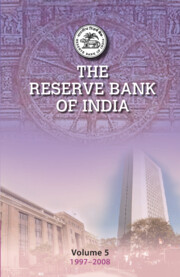Book contents
- Frontmatter
- Contents
- Tables
- Boxes
- Foreword
- Preface
- Acknowledgements
- List of Abbreviations
- 1 Introduction: Managing Liberalisation
- 2 The Macroeconomic Context
- 3 Monetary Management
- 4 Foreign Exchange Market and Management of the Capital Account
- 5 Foreign Exchange Reserves Management
- 6 Financial Markets
- 7 Public Debt Management
- 8 The Payment and Settlement Systems
- 9 Currency Management
- 10 Regulation of the Financial System – Part I: Commercial Banks
- 10 Regulation of the Financial System Part II: Other Financial Institutions
- 11 Supervision of the Financial System
- 12 Rural Credit
- 13 Financial Inclusion
- 14 Communication Policy
- 15 Organisational Change
- Appendices
- Photographs
- Select Bibliography
- Index
6 - Financial Markets
Published online by Cambridge University Press: 10 January 2023
- Frontmatter
- Contents
- Tables
- Boxes
- Foreword
- Preface
- Acknowledgements
- List of Abbreviations
- 1 Introduction: Managing Liberalisation
- 2 The Macroeconomic Context
- 3 Monetary Management
- 4 Foreign Exchange Market and Management of the Capital Account
- 5 Foreign Exchange Reserves Management
- 6 Financial Markets
- 7 Public Debt Management
- 8 The Payment and Settlement Systems
- 9 Currency Management
- 10 Regulation of the Financial System – Part I: Commercial Banks
- 10 Regulation of the Financial System Part II: Other Financial Institutions
- 11 Supervision of the Financial System
- 12 Rural Credit
- 13 Financial Inclusion
- 14 Communication Policy
- 15 Organisational Change
- Appendices
- Photographs
- Select Bibliography
- Index
Summary
Introduction
As a result of the ongoing financial market reforms of the previous decades, there was growing integration among the three main segments of the financial market – the money market, the government securities market and the foreign exchange market – with the money market acting as the fulcrum. But through a series of institutional and technological changes, the process was taken much further during the period of study. And as it continued, the role of financial markets in the economy was significantly enhanced. The chapter describes this process (Figures 6.1 and 6.2).
One of the broader objectives of the reform was to facilitate market integration. Market integration has obvious advantages. It allows economies of scale, more competition, and reduces prices and costs. It allows market participants more choice of investment instruments and allows them to spread risks. Integration also increases the effectiveness of regulation and policy. On the other hand, there is a risk. An integrated market may spread impulses arising in one market to the others, which can be beneficial if the impulse is a growth-inducing one, and hurtful if it is in the nature of a crisis. These expected gains and risks are of special interest to this chapter.
Within the money market, the call money market occupies a strategic position by serving as the equilibrating mechanism between day-to-day surpluses and deficits in the financial markets, and by transmitting the monetary policy impulses to the financial system quickly and efficiently. Consequently, it is the focal point for the Reserve Bank’s operations in influencing liquidity conditions. In the government securities market, major reforms were undertaken to deepen and widen the market, and thereby encourage transactions, and support these with financial accommodation under the liquidity adjustment facility, or LAF (see Chapter 3). The foreign exchange market grew in importance in the context of the large inflow of foreign funds and liberalisation of the foreign exchange regime. The foreign exchange market also operated in close affinity with the call money market on account of the day-to-day liquidity management operations of the Bank.
The rest of the chapter is divided into four main topics: an overview of major developments in the financial markets, the money market, the government securities market and the foreign exchange market.
- Type
- Chapter
- Information
- The Reserve Bank of IndiaVolume 5, 1997–2008, pp. 187 - 226Publisher: Cambridge University PressPrint publication year: 2023



